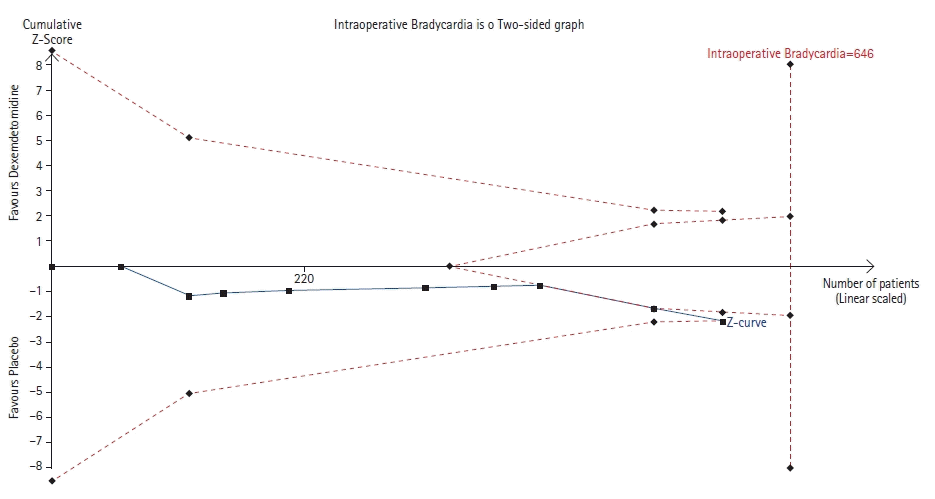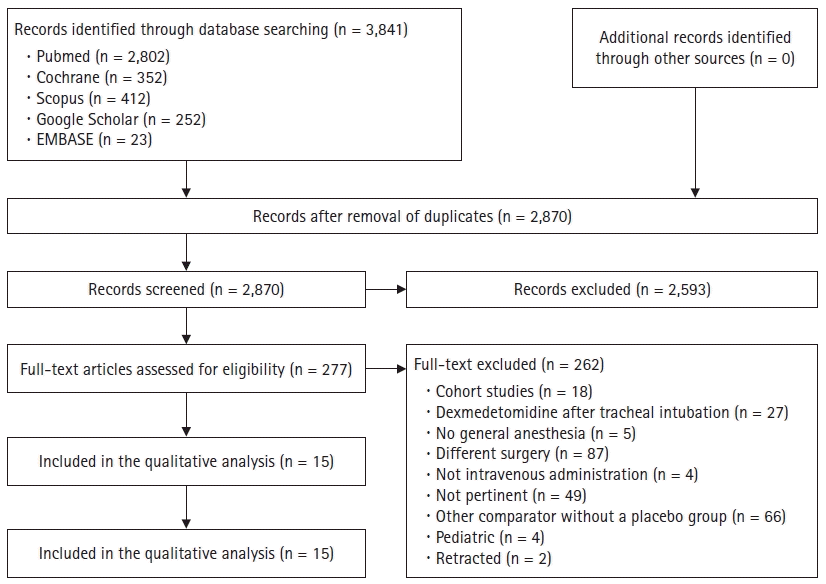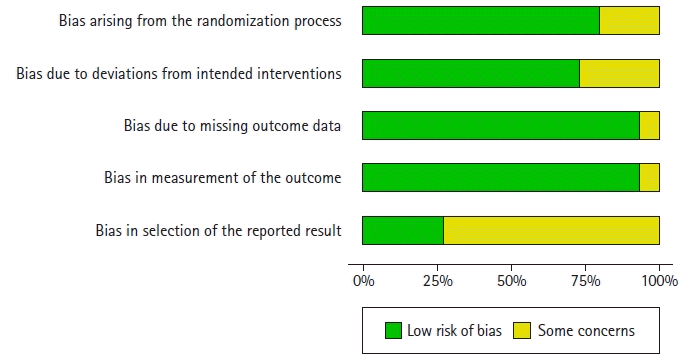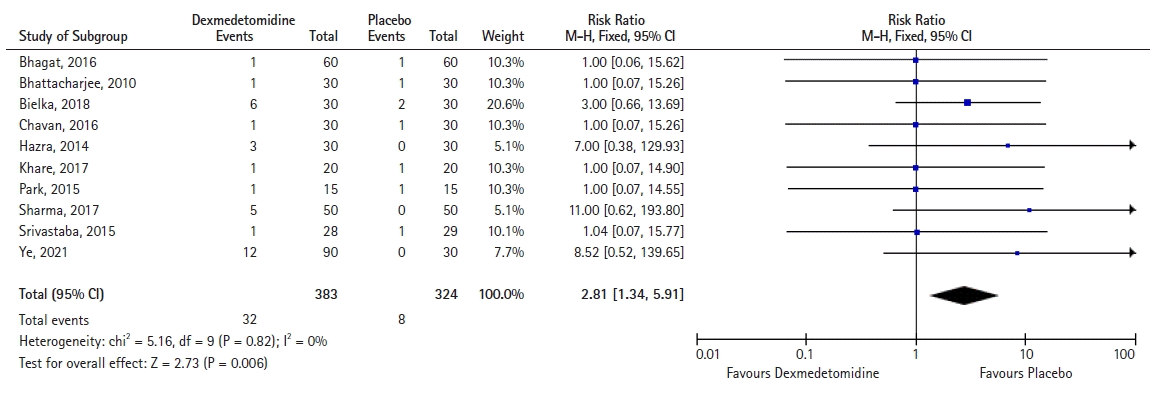1. Di Buono G, Romano G, Galia M, Amato G, Maienza E, Vernuccio F, et al. Difficult laparoscopic cholecystectomy and preoperative predictive factors. Sci Rep. 2021; 11:2559.

2. Larsen JF, Svendsen FM, Pedersen V. Randomized clinical trial of the effect of pneumoperitoneum on cardiac function and haemodynamics during laparoscopic cholecystectomy. Br J Surg. 2004; 91:848–54.

3. Gutt CN, Oniu T, Mehrabi A, Schemmer P, Kashfi A, Kraus T, et al. Circulatory and respiratory complications of carbon dioxide insufflation. Dig Surg. 2004; 21:95–105.

4. Srivastava VK, Nagle V, Agrawal S, Kumar D, Verma A, Kedia S. Comparative evaluation of dexmedetomidine and esmolol on hemodynamic responses during laparoscopic cholecystectomy. J Clin Diagn Res. 2015; 9:UC01–5.

5. Demiri M, Antunes T, Fletcher D, Martinez V. Perioperative adverse events attributed to α2-adrenoceptor agonists in patients not at risk of cardiovascular events: systematic review and meta-analysis. Br J Anaesth. 2019; 123:795–807.

6. De Cassai A, Boscolo A, Geraldini F, Zarantonello F, Pettenuzzo T, Pasin L, et al. Effect of dexmedetomidine on hemodynamic responses to tracheal intubation: a meta-analysis with meta-regression and trial sequential analysis. J Clin Anesth. 2021; 72:110287.

7. Liberati A, Altman DG, Tetzlaff J, Mulrow C, Gøtzsche PC, Ioannidis JP, et al. The PRISMA statement for reporting systematic reviews and meta-analyses of studies that evaluate healthcare interventions: explanation and elaboration. BMJ. 2009; 339:b2700.

8. Sterne JA, Savović J, Page MJ, Elbers RG, Blencowe NS, Boutron I, et al. RoB 2: a revised tool for assessing risk of bias in randomised trials. BMJ. 2019; 366:l4898.

9. Schünemann HJ, Vist GE, Higgins JP, Santesso N, Deeks JJ, Glasziou P, et al. Interpreting results and drawing conclusions. In: Cochrane Handbook for Systematic Reviews of Interventions [Internet]. Higgins J, Thomas J, Chandler J, Cumpston M, Li T, Page M, editors. London: Cochrane;2020. Available from
https://training.cochrane.org/handbook/current/chapter-15.
10. Higgins JP, Thompson SG, Deeks JJ, Altman DG. Measuring inconsistency in meta-analyses. BMJ. 2003; 327:557–60.

12. De Cassai A, Pasin L, Boscolo A, Salvagno M, Navalesi P. Trial sequential analysis: plain and simple. Korean J Anesthesiol. 2021; 74:363–5.

13. Basar H, Akpinar S, Doganci N, Buyukkocak U, Kaymak C, Sert O, et al. The effects of preanesthetic, single-dose dexmedetomidine on induction, hemodynamic, and cardiovascular parameters. J Clin Anesth. 2008; 20:431–6.

14. Bhagat N, Yunus M, Karim HM, Hajong R, Bhattacharyya P, Singh M. Dexmedetomidine in attenuation of haemodynamic response and dose sparing effect on opioid and anaesthetic agents in patients undergoing laparoscopic cholecystectomy- a randomized study. J Clin Diagn Res. 2016; 10:UC01–5.
15. Bhattacharjee DP, Nayek SK, Dawn S, Bandopadhyay G, Gupta K. Effects of dexmedetomidine in hemodynamics in patients undergoing laparoscopic cholecystectomy - a comparative study. J Anaesthesiol Clin Pharmacol. 2010; 26:45–8.

16. Bielka K, Kuchyn I, Babych V, Martycshenko K, Inozemtsev O. Dexmedetomidine infusion as an analgesic adjuvant during laparoscopic сholecystectomy: a randomized controlled study. BMC Anesthesiol. 2018; 18:44.

17. Chavan SG, Shinde GP, Adivarekar SP, Gujar SH, Mandhyan S. Effects of dexmedetomidine on perioperative monitoring parameters and recovery in patients undergoing laparoscopic cholecystectomy. Anesth Essays Res. 2016; 10:278–83.

18. Chilkoti GT, Karthik G, Rautela R. Evaluation of postoperative analgesic efficacy and perioperative hemodynamic changes with low dose intravenous dexmedetomidine infusion in patients undergoing laparoscopic cholecystectomy - A randomised, double-blinded, placebo-controlled trial. J Anaesthesiol Clin Pharmacol. 2020; 36:72–7.

19. Hazra R, Manjunatha SM, Manuar MD, Basu R, Chakraborty S. Comparison of the effects of intravenously administered dexmedetomidine with clonidine on hemodynamic responses during laparoscopic cholecystectomy. Anesth Pain Intensive Care. 2014; 18:25–30.
20. Khanduja S, Ohri A, Panwar M. Dexmedetomidine decreases requirement of thiopentone sodium and pentazocine followed with improved recovery in patients undergoing laparoscopic cholecystectomy. J Anaesthesiol Clin Pharmacol. 2014; 30:208–12.

21. Khare A, Sharma SP, Deganwa ML, Sharma M, Gill N. Effects of dexmedetomidine on intraoperative hemodynamics and propofol requirement in patients undergoing laparoscopic cholecystectomy. Anesth Essays Res. 2017; 11:1040–5.

22. Kholi AV, Ishaq S, Bhadral N, Gulati S, Manhas R. Comparison of efficacy of clonidine vs dexmedetomidine on hemodynamic changes in laparoscopic cholecystectomy. JK Sci. 2017; 19:70–5.
23. Park HY, Kim JY, Cho SH, Lee D, Kwak HJ. The effect of low-dose dexmedetomidine on hemodynamics and anesthetic requirement during bis-spectral index-guided total intravenous anesthesia. J Clin Monit Comput. 2016; 30:429–35.

24. Sharma P, Gombar S, Ahuja V, Jain A, Dalal U. Sevoflurane sparing effect of dexmedetomidine in patients undergoing laparoscopic cholecystectomy: a randomized controlled trial. J Anaesthesiol Clin Pharmacol. 2017; 33:496–502.

25. Ye Q, Wang F, Xu H, Wu L, Gao X. Effects of dexmedetomidine on intraoperative hemodynamics, recovery profile and postoperative pain in patients undergoing laparoscopic cholecystectomy: a randomized controlled trial. BMC Anesthesiol. 2021; 21:63.

26. Zarif P, Abdelaal Ahmed Mahmoud A, Abdelhaq MM, Mikhail HM, Farag A. Dexmedetomidine versus magnesium sulfate as adjunct during anesthesia for laparoscopic colectomy. Anesthesiol Res Pract. 2016; 2016:7172920.

27. Colombo R, Raimondi F, Rech R, Castelli A, Fossali T, Marchi A, et al. Surgical Pleth Index guided analgesia blunts the intraoperative sympathetic response to laparoscopic cholecystectomy. Minerva Anestesiol. 2015; 81:837–45.
28. Slogoff S, Keats AS. Does perioperative myocardial ischemia lead to postoperative myocardial infarction? Anesthesiology. 1985; 62:107–14.

29. Hartmann B, Junger A, Röhrig R, Klasen J, Jost A, Benson M, et al. Intra-operative tachycardia and peri-operative outcome. Langenbecks Arch Surg. 2003; 388:255–60.

30. Bloor BC, Ward DS, Belleville JP, Maze M. Effects of intravenous dexmedetomidine in humans. II. Hemodynamic changes. Anesthesiology. 1992; 77:1134–42.





 PDF
PDF Citation
Citation Print
Print






 XML Download
XML Download